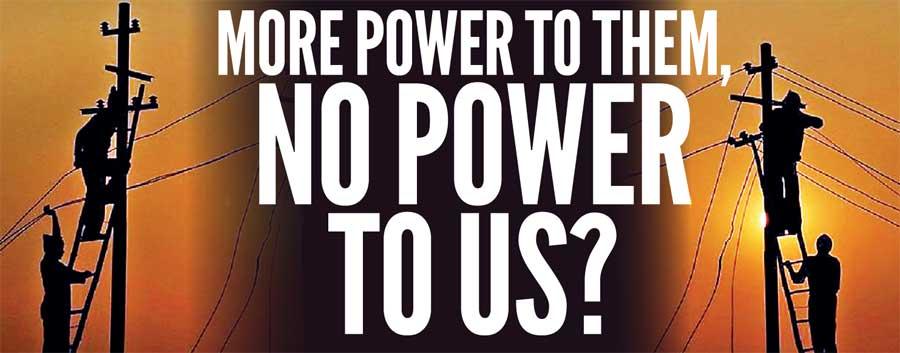Reply To:
Name - Reply Comment

 hen you have so many planners but very few doers in power, this is what happens. Last week was the second or third of what was promised to be a months-long series of rolling power cuts. The Minister in charge, Ravi Karunanayake, has publicly gone on record claiming that the blame game (a reference to the tussle between the Engineers of the CEB and the Public Utilities Commission) must cease, and that, “God willing” (whatever His faith, may He be beneficent!), the rains will come by May. In any case, according to him there will be no need for any blackouts after Avurudu or Vesak (he didn’t specify). He has, moreover, asked for our forgiveness.
hen you have so many planners but very few doers in power, this is what happens. Last week was the second or third of what was promised to be a months-long series of rolling power cuts. The Minister in charge, Ravi Karunanayake, has publicly gone on record claiming that the blame game (a reference to the tussle between the Engineers of the CEB and the Public Utilities Commission) must cease, and that, “God willing” (whatever His faith, may He be beneficent!), the rains will come by May. In any case, according to him there will be no need for any blackouts after Avurudu or Vesak (he didn’t specify). He has, moreover, asked for our forgiveness.
And of course, the emergency power purchases are back. More than 200 MWs of power are to be added to the National Grid, with a couple or so power plant proposals being looked into and, possibly, approved. As of the time this piece was being written the government was in talks with Turkey to (literally) bring in about 500 to 600 MWs of barge mounted power. “Turkey is very happy,” the Minister tells us; whether or not Turkey is happy does not, however, seem to be the issue: as the JVP has pointed out, attempts are being made “to generate power through ships without paying taxes and show a lower number.” Karunanayake attributes 65% of the blame for all this to the politicians, though the people think, justifiably, that’s too low a figure.
There are so many things wrong with what’s being done, but I’ll get down to the bare essentials, the basics. First and foremost, there’s that schedule. We’ve been promised the same routine (in the name of equality, I assume): three hours when the sun is up, one hour when the sun is down. Forget the fact that the schedule was announced long after it was implemented (and that it compelled the Spokesperson of the Ministry of Power and Energy, Sulakshana Jayawardena, to almost resign). Forget the fact that the CEB officials themselves, when contacted, had no clue whether they had imposed the cuts because of the Norochcholai issue or of the lack of rainfall. 
What’s infuriating is the fact that CEB itself doesn’t seem to be doing a good job of spreading the blackouts within the country. This is not just about Colombo not, at least until recently, experiencing power cuts. This is about some areas, outside the suburbs of Colombo that is, having to undergo power cuts amounting to four, even five hours. But even if one discounts it on the basis that the cuts are necessary to preserve what little power the electricity sector (and the government) has, what can exonerate the decision to keep the capital city out of the dark?
Sure, there’s talk about Colombo running on “self-generation” (which adds costs and can raise tariffs if implemented elsewhere), but I don’t imagine that to be a convincing argument to make to hundreds of thousands of outside-Colombo folks, drudging in the heat and dust of April in poorly maintained trains and buses to their places of work, who see switched on streetlights in Union Place at eight in the morning.
Until Thursday of last week, Colombo was immune from these blackouts; I assume, and not without reason, that it was the anger of the public that compelled the regime to extend the blackouts. I won’t even get started on the people’s perception of Colombo being the stronghold of the government, or one Minister’s remark that Colombo was the heart of the UNP, which heads it. But then people remember.
"No one with any level of knowledge about economics and the economic history of this country can discount the “need” for Foreign Direct Investments. "
That’s just one issue, and it has got the attention, the fury, and the contempt it rightly deserves. There’s another issue: along with the capital city, the government has, going by reports and press releases, decided to immunise the Free Trade Export Processing Zones across the country from the outages.
No one with any level of knowledge about economics and the economic history of this country can discount the “need” for Foreign Direct Investments. No one can deny the benefits which, theoretically at least, are to be obtained by facilitating access to prime lands and exempting FDI financed export-oriented enterprises from taxes and other daily hindrances (which the power outages have, as of now, become). For meaningful investments, we need to buckle up and let these enterprises take away from our land and give back to us. Some would call it theft, and I wouldn’t disagree, but unless and until someone comes up with an alternative we need to watch and accept.
However, it does not, and indeed should not, mean that we need to watch and accept in silence as the FTZs and EPZs are exempted from the rolling blackouts. I say this not because I am opposed to these Zones. I say this because the conventional wisdom that they NEED to be exempted does not hold much water when we compare their contribution to the export sector with the contribution of the most vibrant and most innovative and yet worst hit sector of the country, the SMEs.
Let’s crunch the numbers. According to official sources and reports, as of December 2017 the Koggala Export Processing Zone yielded revenues of US$ 122 million; as of March 2018 the Wathupitiwala EPZ yielded US$ 25.6 million; as of December 2018, the Horana EPZ USS$ 31.8 million, while the Seethawaka EPZ, the biggest earner of the lot, yielded US$ 294 million. There are 11 EPZs across the country according to investsrilanka.com; if we take as an average US$ 100 million, then we can safely say that they have, throughout 2018, earned US$ 1.1 billion in export revenues. I may be wrong there, of course; these are, however, conservative estimates.
 Now let’s take the SME sector. Sri Lanka does not have a criterion by which we can categorise such enterprises. Taking the conservative definition – earning less than Rs. 750 million and hiring less than 300 employees (in the manufacturing sector) or less than 200 employees (in the services sector) – we can ascertain the magnitude of the contribution of these entities: they make up more than 75% of local businesses, hire more than 30% of the nation’s workforce, and contribute up to around 53% of the GDP. These percentages have been constant over a considerable period.
Now let’s take the SME sector. Sri Lanka does not have a criterion by which we can categorise such enterprises. Taking the conservative definition – earning less than Rs. 750 million and hiring less than 300 employees (in the manufacturing sector) or less than 200 employees (in the services sector) – we can ascertain the magnitude of the contribution of these entities: they make up more than 75% of local businesses, hire more than 30% of the nation’s workforce, and contribute up to around 53% of the GDP. These percentages have been constant over a considerable period.
Like the middle class, the SMEs contribute substantially to the economy, and yet like the middle class they are also among the worst affected by government incompetence, private sector mafiadoms, and “power” cuts. Commentators have pointed out that the domestic presence of the sector is not commensurate with its meagre presence in the export sector, given that while 80% of the nation’s 5,000 odd exporters are small and medium, they make up around 5% of its export revenues, if not less. But 5% of US$ 17 billion, which was the export revenue figure for 2018, is around US$ 850 million, which is equal to, if not marginally less than, the contribution of the EPZs.
You see the point I’m trying to get at here. The power cuts show clearly just what the government has privileged: FDIs and big investments centred on Colombo and other major cities and outstation areas over the small business owner. The Free Trade Zone Manufacturers’ Association (FTZMA) has, according to the State media, thanked the regime for not implementing the blackouts in their areas. (By that logic, the Ministers themselves, whose areas have also been “power cut immunised”, should be thanking the regime.) No one seems to be talking about the SMEs, though.
Perhaps I should mention here that the FTZMA was vocal in its opposition to the Constitutional Coup we saw last year – in a statement it stated that it was “extremely disturbed and disappointed” at the appointment of Mahinda Rajapaksa – but hasn’t raised as much as a hum over the incompetency of the UNP regime that’s now killing business and killing industry thanks to three years of not taking any decision about the electricity sector. No hems, no haws, no grumbling: just a letter of gratitude, thanking the government (very much) for giving them five-plus-star treatment.
In this scheme of things, the SME has been completely forgotten, and no one in power seems to care. One small business owner, who’s in the construction sector, was vocal about his disappointment with the way things are going.
“I have 15 employees under me, and they work in three factories in Negombo, Marawila, and Chilaw. These power cuts cost me in terms of the man hours lost, the generators, the petrol for those generators, and the transportation of the fuel to each of the factories. That comes up to Rs. 5,000 a day. Earlier I used to earn around Rs. 200,000 as profits per month. With Rs. 5,000 going to power up these generators, how can I continue my business? The government talks about Enterprise Sri Lanka, it talks about Gamperaliya, and it talks about concessionary housing loans to newly married couples. But does it know what it’s doing? I don’t think so.”
So no, the government does not know. Sums it up perfectly, I should think.